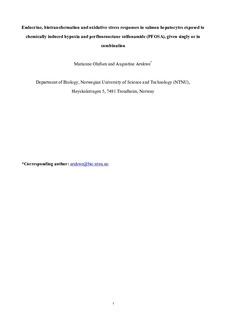| dc.description.abstract | The effects of hypoxia and perfluorooctane sulfonamide (PFOSA), given singly and also in combination on endocrine, biotransformation, and oxidative stress responses were investigated in primary culture of salmon hepatocytes. Hypoxia was induced chemically using cobalt chloride (CoCl2) or deferroxamine (DFO). Primary culture of salmon hepatocytes were exposed to either CoCl2 (150 μM) or DFO (100 μM), in the presence or absence of PFOSA at 0, 25, and 50 μM for 24 and 48 h. Changes in transcript levels were analyzed by quantitative (real-time) PCR using gene-specific primers. CYP, catalase, GST, and SOD activities were analyzed spectrophotometrically. The hif-1α mRNA was used to validate cellular hypoxic condition, showing significantly induced transcription after 48-h exposure to DFO and CoCl2. Our data show that transcript levels for endocrine (ERα, Vtg, and Zrp), biotransformation (cyp1a, cyp3a, gst, and udpgt), and oxidative stress responses (catalase (cat), glutathione peroxidase (gpx), and glutathione reductase (gr)) were differentially modulated by PFOSA and hypoxia alone, and these effects were dependent on the response parameters and time of exposure. In combined exposure scenarios, the observed effects were apparently hypoxia-dependent. However, the observed effects at transcript levels were not concomitant with those at functional protein levels, further emphasizing the potential differences that may exist between these biological levels. Biplot of principal component analysis (PCA) showed grouping of response variables after 48 h of exposure. The distribution of observations and variables indicate that PFOSA had little effect on most response variables, while clustering show a unique association between a given hypoxia condition (i.e., CoCl2 or DFO) in combination with PFOSA and transcripts, proteins, or enzyme activities. | nb_NO |
